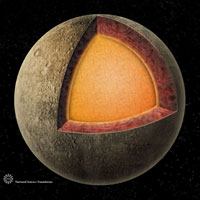
|
Like Venus, Earth and Mars, Mercury is a terrestrial planet, i.e. it is composed of a dense core, rich in iron, and a mantle consisting of magnesium and iron silicates (rocks). The average density of a planet reflects the mass distribution of elements within the planet. Mercurys incompressible average density is very high compared to other planets: 5.3 grams per cubic centimeter. "Incompressible" density means density without compression due to pressure that the planet exerts on itself. The average density of Mercury implies that the metal core is about 65% of the planet.
Several theories attempt to explain this very high density and the large proportion of metal, and each predicts a different composition for Mercury's surface. Unfortunately, the composition of Mercury's surface is still unknown. |
|
Internal structure of Mercury
(credit: JPL/NASA) |
|
Mercury's rotation depends very much on its internal structure. Indeed, the amplitude of the librations and tides vary depending on the internal structure of the planet. Therefore, knowing very precisely the movements/deformations that animate Mercury would greatly help the research on its internal structure. One of BepiColombo mission objectives is to measure the rotation of Mercury with a precision never equaled. Mercury is the only planets, with the Earth, to have a significant magnetic field. We know very little about this magnetic field. Missions to Mercury will reveal key information which, for the first time, will allow us to quantify this magnetic field and to understand its origin. It is also important to study the interactions between the magnetosphere and the activity of the Sun (the solar wind) to understand better the interactions between the Earth's magnetic field and solar wind.
|